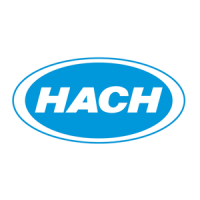69
Appendix B Troubleshooting
B.1 Common Problems, Likely Causes, and Possible Solutions
Very low or erratic recoveries
The most common cause of very low or erratic recoveries is that the
tubes are not being pushed all the way into the block. It is not
enough to simply let them drop into the holes. The tubes must be
pushed in until the stop ring on the collector tube hits the block
surface!
This problem can be also caused by over-preserved samples. For
Cyanide–1, samples are supposed to either be distilled within 24 h
and thus preserved by Micro Distillation or raised to a pH greater
than 12 with very little NaOH. The resulting concentration of NaOH
is about 0.05 M. Addition of too much NaOH to a sample will
prevent the releasing acid from acidifying the sample enough to
release HCN (g). Solution: Either do not preserve samples and
distill them within 24 h of collection to preserve the HCN in them, or
lower the pH with sulfuric acid before running. The second one is
hard to do if the samples are over-preserved as one loses HCN this
way. Over-preservation really ruins the sample.
This problem could also be caused by not pulling off the sample
tubes immediately after removing the collector/sample tube
assembly from the block. “Immediately” is pulling the assembly
from the hot block within 2–3 seconds. If one lets the assembly cool
for much longer, a dramatic suck-back will be seen. A partial
suck-back is also possible and will cause low recoveries. A firm
rocking/twisting and pulling down action along with a little practice
does it. It's all in the wrist!
The sample volume must be 6.0 mL. A pipet must be used and it
should be calibrated. If the sample volume is much higher, there will
not be enough air left in the sample tube during distillation and
suck-back can occur unnoticed.
For method Cyanide–1, the 0.75 mL of releasing acid must be
added from the re-pipettor which should have been calibrated by
dispensing water and weighing it per the instructions on page 7. If
the re-pipettor is set by the marks on the top, it will probably be very
inaccurate. If it is much greater than 0.75 mL, unnoticed suck-back
can occur. This is due to lack of make-up air in the sample tube.
For method Cyanide–1, the method of determination which follows
the distillation must anticipate both 6.0 mL samples and 0.25 M
NaOH. For example, when using USEPA Method 335.2 and scaling
down the reagent quantities, but the solution is diluted to 100 mL as
in Section 8.7.1, color development will not occur. See the
scaled-down version of this method on page 23 for an example.
Some “auto-analyzer” methods anticipate a different concentration
of NaOH. If the undistilled standards used in these methods are not
made up in 0.25 M NaOH, then there will be a matrix effect when
the Micro Distilled samples, which are always in 0.25 M NaOH, are
determined. If the method anticipates a lower concentration, the
samples will give low recoveries; if the method anticipates a higher
NaOH concentration, the samples will give high recoveries.

